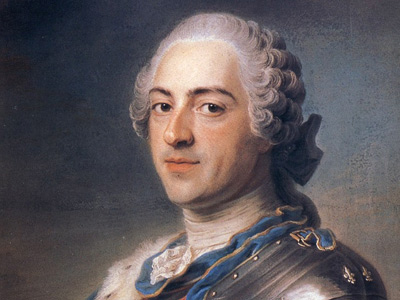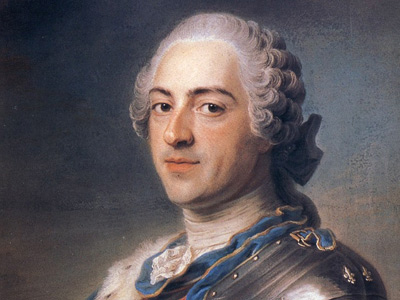Rule with Cardinal de Fleury (1726–1743)
Finances and control of dissent
From 1726 until his death in 1743, Fleury effectively ruled France with the king's assent. Fleury dictated the choices to be made, encouraged the king's indecision and flattered his pride. He forbade the king to discuss politics with the Queen. In order to save on court expenses, he sent the youngest four daughters of the king to be educated at the Abbey of Fontevrault. On the surface it was the most peaceful and prosperous period of the reign of Louis XV, but it was built upon a growing volcano of opposition, particularly from the noble members of the Parlements, who saw their privileges and power reduced. Fleury made the Papal doctrine Unigenitus part of French law and forbade any debate in Parlement, which caused the silent opposition to grow. He also downplayed the importance of the French Navy, which would prove be a fatal mistake in future conflicts.
Fleury showed the King the virtues of a stable government; he kept the same Minister of War, Bauyn d'Angervilliers, and controller of the currency, Philibert Orry, for twelve years, and his minister of foreign affairs, Germain Louis Chauvelin, for ten years. His minister of the Navy and household of the King, the Conte de Maurepas, was in office the entire period. In all he had just thirteen ministers over the course of nineteen years, while the King, in his last thirty-one years, employed forty-three.
Louis's Controller-General of Finances Michel Robert Le Peletier des Forts (1726–1730), stabilized the French currency, though he was expelled for enriching himself in 1730. His successor, Philibert Orry, substantially reduced the debt caused by the War of the Spanish Succession, and simplified and made more fair the tax system, though he still had to depend upon the unpopular dixieme, or tax of the tenth of the revenue of every citizen. Orry managed, in the last two years of Fleury's government, to balance the royal budget, an accomplishment never again repeated during the rest of the reign.
Fleury's government expanded commerce, both within France The Kingdom of France is the historiographical name or umbrella term given to various political entities of France in the medieval and early modern period. It was one of the most powerful states in Europe since the High Middle Ages. It was also an early colonial power, with possessions around the world. Colonial conflicts with Great Britain led to the loss of much of its North American holdings by 1763. The Kingdom of France adopted a written constitution in 1791, but the Kingdom was abolished a year later and replaced with the First French Republic. and with the rest of the world. Transportation and shipping were improved with the completion of the Saint-Quentin canal (linking the Oise and Somme rivers) in 1738, which was later extended to the Escaut River and the Low Countries, and the systematic building of a national road network. By the middle of the 18th century, France had the most modern and extensive road network in the world. The Council of Commerce stimulated trade, and French foreign maritime trade increased from 80 to 308 million livres between 1716 and 1748.
The Kingdom of France is the historiographical name or umbrella term given to various political entities of France in the medieval and early modern period. It was one of the most powerful states in Europe since the High Middle Ages. It was also an early colonial power, with possessions around the world. Colonial conflicts with Great Britain led to the loss of much of its North American holdings by 1763. The Kingdom of France adopted a written constitution in 1791, but the Kingdom was abolished a year later and replaced with the First French Republic. and with the rest of the world. Transportation and shipping were improved with the completion of the Saint-Quentin canal (linking the Oise and Somme rivers) in 1738, which was later extended to the Escaut River and the Low Countries, and the systematic building of a national road network. By the middle of the 18th century, France had the most modern and extensive road network in the world. The Council of Commerce stimulated trade, and French foreign maritime trade increased from 80 to 308 million livres between 1716 and 1748.
The Government continued its policy of religious repression, aimed at the Jansenists and the so-called "Gallicans" in Parlements of nobles. After the dismissal of 139 members of provincial parlements for opposing the official government and papal doctrine of Unigenitus, the Parlement of Paris had to register the Unigenitus papal bull and was forbidden to hear religious cases in the future.
Foreign relations – New alliances; the War of the Polish Succession
In the first years of his governance, Fleury and his foreign minister Germain Louis Chauvelin sought to maintain the peace by maintaining the French alliance with England The Kingdom of Great Britain was a sovereign country in Western Europe from 1 May 1707 to the end of 31 December 1800. The state was created by the 1706 Treaty of Union and ratified by the Acts of Union 1707, which united the kingdoms of England (which included Wales) and Scotland to form a single kingdom encompassing the whole island of Great Britain and its outlying islands, with the exception of the Isle of Man and the Channel Islands., despite their long history of antagonism and their colonial rivalry in North America and the West Indies. They also rebuilt the alliance with Spain
The Kingdom of Great Britain was a sovereign country in Western Europe from 1 May 1707 to the end of 31 December 1800. The state was created by the 1706 Treaty of Union and ratified by the Acts of Union 1707, which united the kingdoms of England (which included Wales) and Scotland to form a single kingdom encompassing the whole island of Great Britain and its outlying islands, with the exception of the Isle of Man and the Channel Islands., despite their long history of antagonism and their colonial rivalry in North America and the West Indies. They also rebuilt the alliance with Spain The Spanish Empire was a colonial empire governed by Spain and its predecessor states between 1492 and 1976. One of the largest empires in history, it was the first to usher the European Age of Discovery and achieve a global scale, controlling vast territory. It was one of the most powerful empires of the early modern period, reaching its maximum extent in the 18th century., which had been shaken by the anger of the Spanish King when Louis refused to marry the Spanish infanta. The birth of the king's male heir in 1729 dispelled the risks of a succession crisis in France. However, new powers were emerging on the European stage, particularly Russia
The Spanish Empire was a colonial empire governed by Spain and its predecessor states between 1492 and 1976. One of the largest empires in history, it was the first to usher the European Age of Discovery and achieve a global scale, controlling vast territory. It was one of the most powerful empires of the early modern period, reaching its maximum extent in the 18th century., which had been shaken by the anger of the Spanish King when Louis refused to marry the Spanish infanta. The birth of the king's male heir in 1729 dispelled the risks of a succession crisis in France. However, new powers were emerging on the European stage, particularly Russia Russian Empire was an empire and the final period of the Russian monarchy from 1721 to 1917, ruling across large parts of Eurasia. The rise of the Russian Empire coincided with the decline of neighbouring rival powers: the Swedish Empire, the Polish–Lithuanian Commonwealth, Qajar Iran, the Ottoman Empire, and Qing China. Russia remains the third-largest empire in history, surpassed only by the British Empire and the Mongol Empire. under Peter the Great and his successor, Catherine I of Russia. Prussia and the Holy Roman Empire
Russian Empire was an empire and the final period of the Russian monarchy from 1721 to 1917, ruling across large parts of Eurasia. The rise of the Russian Empire coincided with the decline of neighbouring rival powers: the Swedish Empire, the Polish–Lithuanian Commonwealth, Qajar Iran, the Ottoman Empire, and Qing China. Russia remains the third-largest empire in history, surpassed only by the British Empire and the Mongol Empire. under Peter the Great and his successor, Catherine I of Russia. Prussia and the Holy Roman Empire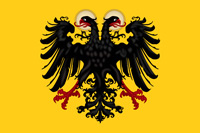 The Holy Roman Empire was a political entity in Western, Central, and Southern Europe that developed during the Early Middle Ages and continued until its dissolution in 1806 during the Napoleonic Wars. From the accession of Otto I in 962 until the twelfth century, the Empire was the most powerful monarchy in Europe. The empire reached the apex of territorial expansion and power in the mid-thirteenth century, but overextending led to partial collapse. of Charles VI were assembling a scattered but impressive empire far as Serbia in Eastern Europe with territories taken from Ottoman Turkey
The Holy Roman Empire was a political entity in Western, Central, and Southern Europe that developed during the Early Middle Ages and continued until its dissolution in 1806 during the Napoleonic Wars. From the accession of Otto I in 962 until the twelfth century, the Empire was the most powerful monarchy in Europe. The empire reached the apex of territorial expansion and power in the mid-thirteenth century, but overextending led to partial collapse. of Charles VI were assembling a scattered but impressive empire far as Serbia in Eastern Europe with territories taken from Ottoman Turkey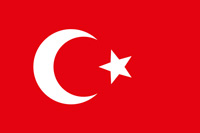 The Ottoman Empire, also known as the Turkish Empire, was an empire that controlled much of Southeast Europe, Western Asia, and Northern Africa between the 14th and early 20th centuries. The Ottomans ended the Byzantine Empire with the conquest of Constantinople in 1453. The Ottoman Empire's defeat and the occupation of part of its territory by the Allied Powers in the aftermath of World War I resulted in its partitioning and the loss of its Middle Eastern territories., and by marriage acquired the Catholic Netherlands (including Belgium), Milan and the Kingdom of Naples.
The Ottoman Empire, also known as the Turkish Empire, was an empire that controlled much of Southeast Europe, Western Asia, and Northern Africa between the 14th and early 20th centuries. The Ottomans ended the Byzantine Empire with the conquest of Constantinople in 1453. The Ottoman Empire's defeat and the occupation of part of its territory by the Allied Powers in the aftermath of World War I resulted in its partitioning and the loss of its Middle Eastern territories., and by marriage acquired the Catholic Netherlands (including Belgium), Milan and the Kingdom of Naples.
A new coalition against France began to assemble in eastern Europe, sealed by a defensive treaty signed on 6 August 1726 between Prussia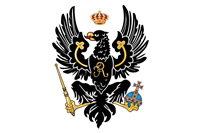 The Kingdom of Prussia was a German kingdom that constituted the state of Prussia between 1701 and 1918. It was the driving force behind the unification of Germany in 1871 and was the leading state of the German Empire until its dissolution in 1918. Although it took its name from the region called Prussia, it was based in the Margraviate of Brandenburg. Its capital was Berlin., Russia and Austria.
The Kingdom of Prussia was a German kingdom that constituted the state of Prussia between 1701 and 1918. It was the driving force behind the unification of Germany in 1871 and was the leading state of the German Empire until its dissolution in 1918. Although it took its name from the region called Prussia, it was based in the Margraviate of Brandenburg. Its capital was Berlin., Russia and Austria.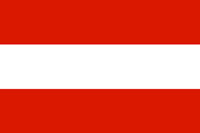 The Archduchy of Austria was a major principality of the Holy Roman Empire and the nucleus of the Habsburg monarchy. With its capital at Vienna, the archduchy was centered at the Empire's southeastern periphery. The archduchy's history as an imperial state ended with the dissolution of the Holy Roman Empire in 1806. It was replaced with the Lower and Upper Austria crown lands of the Austrian Empire. In 1732 the coalition came into direct conflict with France over the succession to the Polish throne. The King of Poland and Elector of Saxony, Augustus II, was dying, and his official heir was Stanisław Leszczyński, the father of the Queen of France. In the same year Russia, Prussia and Austria signed a secret agreement to exclude Stanisław from the throne, and put forward another candidate, Augustus III, son of the dead Polish king. The death of Augustus on 1 February 1733, with two heirs claiming the throne, launched the War of the Polish Succession. Stanislaw traveled to Warsaw, where he was crowned King of Poland and Grand Duke of Lithuania on 12 September. The Tsarina of Russia immediately marched her regiments into Poland to support her candidate. Stanislaw was forced to flee to the fortified port of Danzig (now Gdańsk), while on 5 October Augustus III was crowned in Warsaw.
The Archduchy of Austria was a major principality of the Holy Roman Empire and the nucleus of the Habsburg monarchy. With its capital at Vienna, the archduchy was centered at the Empire's southeastern periphery. The archduchy's history as an imperial state ended with the dissolution of the Holy Roman Empire in 1806. It was replaced with the Lower and Upper Austria crown lands of the Austrian Empire. In 1732 the coalition came into direct conflict with France over the succession to the Polish throne. The King of Poland and Elector of Saxony, Augustus II, was dying, and his official heir was Stanisław Leszczyński, the father of the Queen of France. In the same year Russia, Prussia and Austria signed a secret agreement to exclude Stanisław from the throne, and put forward another candidate, Augustus III, son of the dead Polish king. The death of Augustus on 1 February 1733, with two heirs claiming the throne, launched the War of the Polish Succession. Stanislaw traveled to Warsaw, where he was crowned King of Poland and Grand Duke of Lithuania on 12 September. The Tsarina of Russia immediately marched her regiments into Poland to support her candidate. Stanislaw was forced to flee to the fortified port of Danzig (now Gdańsk), while on 5 October Augustus III was crowned in Warsaw.
Cardinal Fleury responded with a carefully-orchestrated campaign of diplomacy. He first won assurances from Britain and Holland that they would not interfere in the war, while lining up alliances with Spain and the King of Sardinia in exchange for pieces of the Hapsburg Empire. On 10 October 1733, Louis formally declared war against Austria. A French army occupied the Duchy of Lorraine and then Alsace, while another crossed the Alps and captured Milan on 3 November, handing it over to the King of Sardinia. Fleury was less energetic in his actions to restore the Polish throne to Stanlslaw, who was blockaded by the Russian navy and army in Danzig. Instead of sending the largest part of the French fleet from its station off Copenhagen to Danzig, he ordered it to return to Brest and sent only a small squadron with two thousand soldiers, which after a fierce action was sunk by the Russians. On 3 July Stanislaw was forced to flee again, in disguise, to Prussia, where he became the guest of King Frederick William I of Prussia in the castle of Koenigsburg.
To bring the war to an end, Fleury and Charles VI negotiated an ingenious diplomatic solution. Francis III, Duke of Lorraine, left Lorraine for Vienna, where he married Maria Theresa, the heir presumptive to the Hapsburg thrones. The vacant throne of Lorraine was to be occupied by Stanislav, who abandoned his claim to the Polish throne. Upon the death of Stanislaw, the Duchy of Lorraine and Bar would become part of France. Francis, as the future emperor, would be compensated for the loss of Lorraine by the granting of the Duchy of Tuscany. The King of Sardinia would be compensated with certain territories in Lombardy; while the Sardinians would return Naples, in exchange for Parma and Plaisance. The marriage of Francis of Lorraine and Maria Theresa took place in 1736, and the other exchanges took place in turn. With the death of Stanislav in 1766, Lorraine and the neighboring Duchy of Bar became part of France.
In September 1739, Fleury scored another diplomatic success. France's mediation in the war between the Holy Roman Empire and the Ottoman Empire led to the Treaty of Belgrade (September 1739), which favoured the Ottoman Empire, beneficiary of a Franco-Ottoman alliance against the Habsburgs since the early 16th century. As a result, the Ottoman Empire in 1740 renewed the French capitulations, which marked the supremacy of French trade in the Middle East. With these successes, Louis XV's prestige reached its highest point. In 1740 William I, the King of Prussia declared "Since the Treaty of Vienna France is the arbiter of Europe."
The War of the Austrian Succession
On 29 October 1740, a courier brought the news to the King, who was hunting in Fontainebleau, that the Emperor Charles VI was dead, and his daughter Maria Theresa was set to succeed him. After two days of reflection, Louis declared, "In these circumstances, I don't want to get involved at all. I will remain with my hands in my pockets, unless of course they want to elect a protestant emperor." This attitude did not please France's allies, who saw an opportunity to take parts of the Hapsburg empire, or Louis's generals, who for a century had won glory fighting Austria. The King of Prussia had died on 31 May and was succeeded by his son Frederick the Great, a military genius with ambitions to expand Prussia's borders. The elector of Bavaria, supported by Frederick, challenged the succession of Maria Theresa, and on 17 December 1740 Frederick invaded the Austrian province of Silesia. The elderly Cardinal Fleury had too little energy left to oppose this war.
Fleury sent his highest ranking general, Charles Louis Auguste Fouquet, duc de Belle-Isle, the Maréchal de Belle-Isle, the grandson of Fouquet, the famous disgraced controller of finances of Louis XIV, as his ambassador to the Diet of Frankfurt, with instructions to avoid a war by supporting the candidacy of the Elector of Bavaria to the Austrian throne. Instead, the Maréchal, who detested the Austrians, made an agreement to join with the Prussians against Austria, and the war began. French and Bavarian armies quickly captured Linz and laid siege to Prague. On 10 April 1741 Frederick won a major victory over the Austrians at the Battle of Molwitz. On 18 May, Fleury assembled a new alliance combining France, Spain and Bavaria, later joined by Poland and Sardinia. However, in 1742, the balance of the war shifted against France. The German-born British King, George II, who was also the Elector of Hanover, joined the war on the side of Austria and personally took charge of his soldiers fighting the French in Germany. Maria Theresa's Hungarian army recaptured Linz and marched into Bavaria as far as Munich. In June, Frederick of Prussia withdrew from the alliance with France, after gaining the crown of Silesia from the Austrians. Belleville had to abandon Prague, with a loss of eight thousand men. For seven years, France was engaged in a costly war with constantly shifting alliances. Orry, the superintendent of French finance, was forced to reinstate the highly unpopular dixieme tax to fund the war. Cardinal de Fleury did not live to see the end of the conflict; he died on 29 January 1743, and thereafter Louis ruled alone.
The war in Germany was not going well; the French and Bavarian forces were faced with the combined armies of Austria, Saxony, Holland, Sardinia and Hanover. The army of the Duke of Noailles was defeated by a force of British, Hessian and Hanover soldiers led by George II at the battle of Dettingen, and in September French forces were compelled to abandon Germany.
In 1744, the Netherlands became the primary battlefield of the war, and the French position began to improve. Frederick the Great decided to rejoin the war on the French side. Louis XV left Versailles to lead his armies in the Netherlands in person, and French field command was given to the German-born Maréchal Maurice de Saxe, a highly competent general. At the Battle of Fontenoy on 11 May 1745, Louis, accompanied by his young son the Dauphin, came under fire for the first time and witnessed a French victory over combined British, Dutch The Dutch Republic was a confederation that existed from 1579, during the Dutch Revolt, to 1795. It was a predecessor state of the Netherlands and the first fully independent Dutch nation state. Although the state was small and contained only around 1.5 million inhabitants, it controlled a worldwide network of seafaring trade routes. The income from this trade allowed the Dutch Republic to compete militarily against much larger countries. It amassed a huge fleet of 2,000 ships, initially larger than the fleets of England and France combined. and Austrian forces. When the Dauphin became excited at the sight of so many dead enemy soldiers, the King told him, "You see what a victory costs. The blood of our enemies is still the blood of men. The true glory is to spare it." Saxe went on to win further victories at Rocoux (1746) and Lauffeld (1747). In 1746 French forces besieged and occupied Brussels, which Louis entered in triumph. The King gave de Saxe the Chateau de Chambord in the Loire Valley as a reward for his victories.
The Dutch Republic was a confederation that existed from 1579, during the Dutch Revolt, to 1795. It was a predecessor state of the Netherlands and the first fully independent Dutch nation state. Although the state was small and contained only around 1.5 million inhabitants, it controlled a worldwide network of seafaring trade routes. The income from this trade allowed the Dutch Republic to compete militarily against much larger countries. It amassed a huge fleet of 2,000 ships, initially larger than the fleets of England and France combined. and Austrian forces. When the Dauphin became excited at the sight of so many dead enemy soldiers, the King told him, "You see what a victory costs. The blood of our enemies is still the blood of men. The true glory is to spare it." Saxe went on to win further victories at Rocoux (1746) and Lauffeld (1747). In 1746 French forces besieged and occupied Brussels, which Louis entered in triumph. The King gave de Saxe the Chateau de Chambord in the Loire Valley as a reward for his victories.
HISTORY
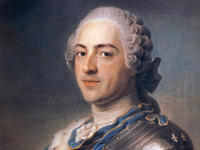
RESOURCES
This article uses material from the Wikipedia article "Louis XV of France (1710-1774)", which is released under the Creative Commons Attribution-Share-Alike License 3.0.
© Stories Preschool. All Rights Reserved.
